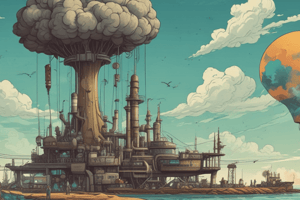Podcast
Questions and Answers
What is air pollution and what are its primary sources?
What is air pollution and what are its primary sources?
Air pollution is the release of pollutants into the atmosphere, harming human health and the environment. Its primary sources are industrial activities, vehicle emissions, and fossil fuel combustion.
What are the effects of water pollution on aquatic life and human health?
What are the effects of water pollution on aquatic life and human health?
Water pollution can harm aquatic life and human health, causing harm to aquatic life, human illness, and eutrophication.
What is bioaccumulation, and what are its consequences?
What is bioaccumulation, and what are its consequences?
Bioaccumulation is the buildup of pollutants in organisms, leading to toxicity and biomagnification.
What is biomagnification, and how does it affect ecosystems?
What is biomagnification, and how does it affect ecosystems?
What is population decline, and how is it related to pollution?
What is population decline, and how is it related to pollution?
What is bioremediation, and how does it help to mitigate pollution?
What is bioremediation, and how does it help to mitigate pollution?
What is teratogenesis, and what are its consequences?
What is teratogenesis, and what are its consequences?
What is adaptation in the context of pollution, and how do organisms adapt to polluted environments?
What is adaptation in the context of pollution, and how do organisms adapt to polluted environments?
Flashcards are hidden until you start studying
Study Notes
Types of Pollution
- Air Pollution: release of pollutants into the atmosphere, harming human health and the environment
- Sources: industrial activities, vehicle emissions, fossil fuel combustion
- Effects: respiratory problems, acid rain, climate change
- Water Pollution: contamination of water bodies, affecting aquatic life and human health
- Sources: industrial waste, agricultural runoff, sewage
- Effects: harm to aquatic life, human illness, eutrophication
- Soil Pollution: contamination of soil, affecting plant growth and human health
- Sources: industrial waste, agricultural chemicals, mining activities
- Effects: reduced fertility, plant toxicity, human health risks
- Noise Pollution: excessive noise levels, disrupting human health and wildlife
- Sources: industrial activities, transportation, construction
- Effects: hearing loss, stress, disrupted wildlife habitats
Effects of Pollution on Living Organisms
- Mutagenesis: genetic mutations caused by pollutants, leading to birth defects and cancer
- Teratogenesis: pollutants causing developmental abnormalities in embryos
- Bioaccumulation: buildup of pollutants in organisms, leading to toxicity and biomagnification
- Biomagnification: increase in pollutant concentrations as they move up the food chain
Biological Impacts of Pollution
- Population Decline: reduced population sizes due to pollution-induced mortality
- Changes in Species Composition: shifts in community structure due to pollution tolerance
- Disruption of Food Webs: impacts on predator-prey relationships and ecosystem stability
- Loss of Biodiversity: reduction in species diversity and ecosystem resilience
Biological Responses to Pollution
- Adaptation: evolutionary changes in response to pollution pressure
- Tolerance: physiological changes allowing organisms to survive in polluted environments
- Bioindication: using organisms as indicators of pollution levels and ecosystem health
- Bioremediation: using organisms to remove pollutants from the environment
Types of Pollution
- Air pollution is caused by industrial activities, vehicle emissions, and fossil fuel combustion, leading to respiratory problems, acid rain, and climate change.
- Water pollution is caused by industrial waste, agricultural runoff, and sewage, affecting aquatic life and human health, and leading to harm to aquatic life, human illness, and eutrophication.
- Soil pollution is caused by industrial waste, agricultural chemicals, and mining activities, affecting plant growth and human health, and leading to reduced fertility, plant toxicity, and human health risks.
- Noise pollution is caused by industrial activities, transportation, and construction, disrupting human health and wildlife, and leading to hearing loss, stress, and disrupted wildlife habitats.
Effects of Pollution on Living Organisms
- Mutagenesis occurs when pollutants cause genetic mutations, leading to birth defects and cancer.
- Teratogenesis occurs when pollutants cause developmental abnormalities in embryos.
- Bioaccumulation is the buildup of pollutants in organisms, leading to toxicity and biomagnification.
- Biomagnification is the increase in pollutant concentrations as they move up the food chain.
Biological Impacts of Pollution
- Pollution can lead to population decline due to pollution-induced mortality.
- Changes in species composition occur when pollution tolerant species replace sensitive species.
- Disruption of food webs occurs when pollutants affect predator-prey relationships and ecosystem stability.
- Pollution leads to loss of biodiversity, reducing species diversity and ecosystem resilience.
Biological Responses to Pollution
- Adaptation is an evolutionary change in response to pollution pressure.
- Tolerance is a physiological change allowing organisms to survive in polluted environments.
- Bioindication is using organisms as indicators of pollution levels and ecosystem health.
- Bioremediation is the use of organisms to remove pollutants from the environment.
Studying That Suits You
Use AI to generate personalized quizzes and flashcards to suit your learning preferences.




